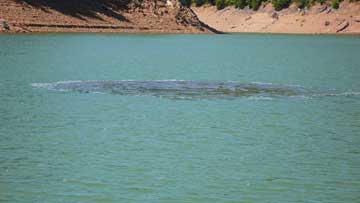|
NEWS NOTES
Geophenomena
No Green Peter Nessie: just gas
 Army Corps of Engineers |
Not-so-tiny bubbles that burbled up from the bottom of Oregon’s Green Peter reservoir this summer were neither harbingers of an imminent volcanic eruption nor of a prehistoric monster lurking in the depths, despite speculations about both. Instead, they were just gases produced by decomposing organic matter in the reservoir sediment, according to the Army Corps of Engineers.
Recreational visitors to the reservoir, which is located in the Willamette Valley near Albany, Ore., were alarmed in late July when they spied a large region of dark water in the middle of the lake, according to a July 20 story in the Albany Democrat-Herald. A second dark spot, about eight meters in diameter, appeared shortly afterward in the same part of the lake, following a sudden burst of bubbles. The region was full of debris and “was really dark, like a black hole,” a couple told the paper.
After learning of the events, members of the Army Corps of Engineers’ Portland District investigated the bubbles’ origin. One likely possibility was that they might be geothermal, as there are several hot springs in the vicinity, says Erik Petersen, the Willamette Valley projects manager for the Corps, which operates the Green Peter Dam and manages the reservoir.
The Corps never saw the events as a potential risk to human health or to the environment, unlike the devastating gas disasters that occurred in 1984 in Cameroon’s Lake Monoun and in 1986 in Cameroon’s Lake Nyos, in which enormous volumes of carbon dioxide were released suddenly from the lakes and caused widespread asphyxiation (see Geotimes, December 2005). Scientists think that those disasters occurred when gas-rich groundwater at the base of the lake, enriched with gases from a magma source underground, suddenly became unstable and burst to the surface.
At Green Peter, the bubbles of gas have a more benign source — decomposition from organic matter that collects in the reservoir, Petersen says. One telltale indicator right away is that Corps members investigating the events detected no sulfur smell, which might indicate a geothermal source, he says.
The Corps also sent down a remotely operated vehicle (ROV) to film the reservoir’s bottom, and observed large amounts of organic debris beneath the turbid waters, says Jim Britton, a biologist at the Corps’ Portland District. “When the ROV [struck bottom], the sediment would all fluff up, and we saw bubbles coming up out of it,” Britton says. “That part of the reservoir serves as a deposit area” for sediment, particularly when the reservoir water level is dropped in preparation for winter, he says, and bubbling events may in fact be occurring periodically there and elsewhere in the reservoir.
Bubble samples collected by the Corps revealed that they consisted of 55 percent methane and about 4 percent carbon dioxide. Although carbon isotope analyses would reveal the source of the gases more explicitly, the Corps has expressed more curiosity than urgency about their origin. But one thing is clear: There’s not likely to be another Loch Ness monster stirring up the sediment.
Links:
"Halting exploding lakes," Geotimes, December 2005

 Subscribe
Subscribe


